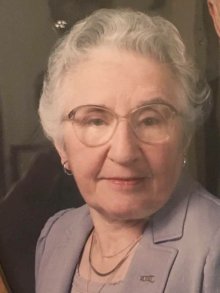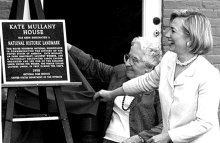
By DEB ESCOBAR on July 31, 2017
On July 17, 2017, Josephine Sano passed on from this mortal life at the age of 97. A lifelong union activist, her achievements and leadership are an example for all of us and will be remembered long after her death.
Josephine Sano was born in Queens, but moved to Gloversville where she was raised in a home that was instilled with union ideals. Her father was a unionized barber, and her aunt had been a part of the International Ladies Garment Workers Union and had worked closely with legendary union leader David Dubinsky. Surrounded by workers, she learned firsthand about the power of standing up for others and exerting leadership for social objectives. A diminutive figure physically, the power she exerted as a teacher and a leader was formidable from her youth. According to her son Joseph, her core values of “Family, Faith, and Union Family” were the foundation of Josephine’s life, and she passed those values on to her three sons Joseph, John, and Jim. John became an engineer, while Joseph and Jim followed in their mother’s footsteps and became teachers and union activists.
Sano graduated from the New York State College for Teachers in 1941, where she paid for her own education by working. It is of note that during this era, women – and especially women from traditional Italian homes – were discouraged from attending college. When asked years later about her decision to further her education, she told a reporter for the Italian-American Community Center that “To do anything else would not have made any sense to me.”
After college, she taught for two years at Berne-Knox-Westerlo School District, but was denied tenure for teaching lessons about race tolerance and the Ku Klux Klan, a subject which was not openly discussed in the 1940’s. She was hired as a substitute teacher in the Albany School District but had a difficult time getting a probationary position because women of childbearing age were simply not hired. At that time, school administrators hesitated to invest in a teacher who might be leaving because of maternity issues. In 2006, when Josephine was honored with the Sandra Feldman Not For Ourselves Alone Award from NYSUT, she touched on these roots when she stated that “Things like maternity leave and tenure are not birthrights, but hard-fought gains.” She had to be diligent in order to obtain her full-time teaching position. She worked in the classroom for 44 years until her retirement in 1986.
Sano became the President of the Albany Public School Teachers Association in 1971 and kept that position for ten years. The City School District of Albany Hall of Fame website states that “She changed forever the structure of the Albany Public Schools Teachers Association, transforming it from what she described as an ‘afternoon tea society,’ into a modern, forward-looking organization representing teachers.” At the time, teachers’ unions were dominated by administrators, but according to past APSTA president Bill Ritchie (now the President of the Capital Area Central Federation of Labor), Sano “turned it from a bosses’ union to a workers’ union, and led their executive committee to become the strongest in the region. Contracts in Albany were without comparison, and working conditions improved.”
In the 60's and 70's, Mayor of Albany Erastus Corning II used control of city infrastructure to maintain and solidify the authority of his political machine. He appointed his cronies as school board members, and nothing could be accomplished in the district without his permission. According to her son Joe, his mother “immediately went toe-to-toe with Corning about wages, working conditions, and class size.” She stood up to the powerful mayor not only for teachers, but for all public employees. When Corning tried to prevent the firemen from organizing, she stood by them and got the Albany Teachers’ Union to support them both politically and financially as they established their union. She was also instrumental in helping many teachers' locals, and supported all municipal employees as they organized.
As President of the APSTA, Josephine became very involved in the New York State Teachers’ Association, an upstate group affiliated with the National Education Association (NEA). Before 1972, NYSTA and the United Teachers of New York (affiliated with AFT) were separate and often competing organizations, and their achievements were limited by their lack of unity. Paul Cole recalls that Josephine “became the champion for the merger of the two organizations, contacting and instructing locals within the Capital District and the broader Eastern region about the importance of unifying their efforts.” In 1972, the resolution to merge and form the New York State United Teachers (NYSUT) was overwhelmingly approved, in no small part due to her efforts. Though her leadership was well known, she shied away from running for regional or statewide office in the organization because she never wanted to leave the classroom. She served the organization in other ways, becoming the original Capital District VOTE-COPE coordinator and a longtime delegate to both NYSUT and AFT. In 1974 and 1975 she served on NYSUT’s Statewide Task Force on Affirmative Action.
Ritchie recalls that Josephine was “intensely focused on defending working people and always ready to take on any adversaries of the union movement…she was a fearless fighter.” She could often be found in strike lines for her union family, and was there to support wherever needed, even though she did not drive. At first her husband, and later Walt Wheeler of the Albany County Central Federation of Labor (ACCFL) and Sue Waltz of the CSEA were her unofficial “union drivers.”
She became the first woman president of the ACCFL from 1981 to 2000, and served as President Emeritus of the organization for the rest of her life. Her strong leadership strengthened the council that included CSEA, AFT, American Federation of State, County and Municipal Employees, Communication Workers of America, Public Employees Federation, and Teamsters.
A family memory reflects the fierce nature of her activism. Josephine’s husband Joseph was the legislative representative for the Letter Carriers Association. Her son, named after his father, was the President of the Guilderland Teachers’ Association. All three were affectionately known as “Joe.” A reporter called the home one day and Josephine’s son Jim answered. When the reporter asked to speak with the Joe who was a union activist, Jim answered “Do you want the Father, the Son, or the Holy Terror?” She certainly was able to “strike terror” into the heart of any who opposed workers’ rights.
She was also very active on behalf of York State Manor, a nursing home for indigent teachers in the Syracuse area. She raised money for the Mary Muldoon Fund that supported the home, and her efforts helped to keep it going for many years, until the home had to be sunsetted because of declining enrollment.

Sano was a host for First Lady Hillary Clinton at the designation of the Kate Mullany House as a National Historic Landmark on July 15, 1998.
She received many honors over the course of her life, including an honorary degree from Cornell School of Industrial Relations, the Taft Institute of Government Scholarship at Russell Sage College (1972), Award of Merit of the Capital District Union Label and Services Trade Council of the AFL-CIO (1987), Capital District Chamber of Commerce Women of Excellence Award (2000), and the Sandra Feldman Not For Ourselves Alone Award, from NYSUT in 2006.
She often referred to a quote that was based on an old Tibetan proverb and further attributed to Hubert Humphrey stating “It is better to live one day as a tiger than to live a lifetime as a chicken.” She lived a lifetime as a tiger, and her passion and her struggle made life better for not only those she worked with and led, but for those workers who would come long after her.
If you are inspired by Josephine Sano's life, click here to find some ideas for how you can make a difference for union causes:
http://rc10.ny.aft.org/take-action/how-live-day-tiger-union-causes
